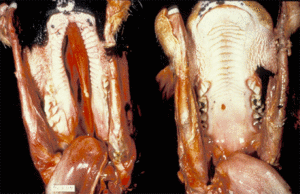Difference between revisions of "Cleft Palate"
| Line 84: | Line 84: | ||
[[Category:Respiratory System - Developmental Pathology]] | [[Category:Respiratory System - Developmental Pathology]] | ||
[[Category:Oral Cavity - Developmental Pathology]] | [[Category:Oral Cavity - Developmental Pathology]] | ||
| − | [[Category:Oral Diseases - Cattle]][[Category:Oral Diseases - Horse]][[Category:Goat]][[Category:Pig]][[Category:Sheep]] | + | [[Category:Oral Diseases - Cattle]][[Category:Oral Diseases - Horse]][[Category:Alimentary Diseases - Goat]][[Category:Alimentary Diseases - Pig]][[Category:Alimentary Diseases - Sheep]] |
[[Category:Oral Diseases - Cat]][[Category:Oral Diseases - Dog]] | [[Category:Oral Diseases - Cat]][[Category:Oral Diseases - Dog]] | ||
[[Category:Expert_Review]] | [[Category:Expert_Review]] | ||
Revision as of 18:52, 17 January 2011
| This article has been peer reviewed but is awaiting expert review. If you would like to help with this, please see more information about expert reviewing. |
Also known as: Congenital oronasal fistula — Palatoschisis
Description
An abnormal communication between the nasal and oral cavities involving the soft palate , hard palate, premaxilla and or lip . Abnormalities arise during foetal development where there is incomplete closure of the primary palate, secondary palate or both. The primary palate develops into the premaxilla and lip. If closure is not complete this will result in a primary palate or cleft lip (harelip). The secondary palate forms the hard and soft palate and incomplete closure of either of these results in a secondary palate or cleft palate.
Signalment
Dogs are more commonly affected than cats. In particular brachycephalic breeds are more commonly affected due to the intra-uterine growth characteristics of the skull. Other at risk dog breeds include, Boston terriers, Pekingese, minature schnauzers, beagles and cocker spaniels. Siamese are the most commonly affected cat breed. Present at birth but not always noticed straight away. In large animals, cleft palate has been reported in foals, calves, lambs and kids. The primary cause of this condition is often hereditary but maternal nutritional deficiencies, toxins and viral exposure have also been implemented.
Diagnosis
History and Clinical Signs
Failure to thrive with signs such as nasal discharge, nasal milk regurgitation, gagging, coughing or sneezing during nursing, and respiratory infection due to aspiration pneumonia or rhinitis.
Diagnosis is made on physical exam. A cleft lip can be easily identified, however, a full oral examination is needed to diagnose incomplete closure of the premaxilla, hard and soft palate. In some instances anaesthesia may be required to diagnose a soft palate problem. If a primary palate problem is recognised always check for a secondary palate problem. Increased noise over lung fields may be heard if aspiration pneumonia is present. Affected animals often have other concurrent congenital abnormalities and hence a thorough physical exam should be undertaken.
Laboratory Tests
Often normal unless aspiration pneumonia is present.
Radiography
Radiographs of the skull are unnecessary however thoracic radiographs are useful to check for the presence of aspiration pneumonia.
Treatment
A large proportion of animals with primary or secondary palate defects die or are euthanased. In some cases however the defects can be managed medically until the patient is old enough for surgery.
Affected animals should gain nutritional support via a feeding tube to avoid aspiration pneumonia until surgery can be undertaken. Aspiration pneumonia should also be treated with appropriate antibiotics, expectorants and oxygen. Surgery should be delayed until the animal is 12-14 weeks old or longer if possible in order to get the best possible post surgical outcome. More mature tissue is less friable and holds suture better. Surgical correction is normally only carried out if the defect is small and owners must be warned that more severely affected animals may need multiple procedures.
Closure of Primary Clefts
Often very difficult to correct surgically, and requires planning and multiple surgeries.
Closure of Secondary Clefts
Hard palate defects
Three procedures have been described firstly, the Lagenbeck or sliding pedicle technique whereby longitudinal strips of mucosa are released from the hard palate and slid together at the midline. Hard palate bone is exposed laterally however granulation and epithelisation occur quickly. The second technique is the Sandwich or overlapping flap technique where by a recipient bed is created by splitting the mucous membrane at the edge of the defect. A donor bed is created by releasing strips of mucosa from the opposite mucous membrane which is then sutured into place. Thirdly a combination technique can be applied where both of the above techniques are used to produce a double layer of mucosa over the cleft.
Soft Palate defects
An overlapping flap technique, flaps from the hard palate and nasopharangeal mucosa flaps can be used to repair soft palate deformities.
Post operatively patients should be fed via a tube to prevent trauma to the surgical site and to maintain nutritional intake. Dehiscence and recurrence can occur following movement, tension and growth.
Prognosis
Historically, surgical correction of these conditions had a low success rate. More recently new surgical techniques can result in a good prognosis, however, multiple surgeries may be required and aspiration pneumonia must be treated.
Test yourself with the Oral Cavity Pathology Flashcards
Oral Cavity Pathology Flashcards
Literature Search
Use these links to find recent scientific publications via CAB Abstracts (log in required unless accessing from a subscribing organisation).
Cleft palate in Dogs publications
Cleft palate in Horses publications
Cleft palate in Cats publications
Cleft palate in Farm Animals publications
References
Fossum, T. W. et. al. (2007) Small Animal Surgery (Third Edition) Mosby Elsevier
Merck & Co (2008) The Merck Veterinary Manual (Eighth Edition) Merial

